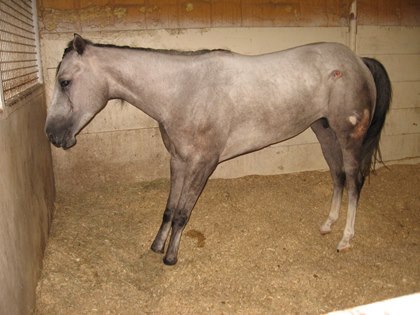Is My Horse Predisposed to Hyperinsulinemia-Associated Laminitis?

Hyperinsulinemia-associated laminitis (HAL) in horses is a painful hoof condition caused by metabolic problems. Owners of affected horses typically must adopt permanent management changes to prevent recurrence. Horses with HAL are insulin-dysregulated, meaning they have abnormally high levels of insulin in the bloodstream, and carry excessive fat (adipose) tissue all over or in certain areas—a cluster of clinical abnormalities known as equine metabolic syndrome (EMS). “Insulin dysregulation is the core element of metabolic problems, while other factors, including HAL, are secondary,” said Simon Bailey, PhD, BVMS, FHEA, Dipl. ECVPT, FRCVS, professor of veterinary biosciences at the University of Melbourne in Victoria, Australia, during his presentation at the 2023 American College of Veterinary Internal Medicine Forum, held June 15-17 in Philadelphia, Pennsylvania. In his talk Bailey described risk factors for HAL—those characteristics that increase a horse’s chance of developing the condition.
Genetics and Breed Associations
Veterinarians most commonly see metabolic problems in ponies and obese equids, said Bailey. “In some studies, about half of mature light-breed horses in the U.S. were overweight or obese, and an Australian study indicated that 15% of pleasure horses and ponies have suffered from at least one laminitic episode.” Researchers have recognized a clear association between insulin dysregulation and pony breeds, but Spanish and gaited horse breeds, Miniature Horses, and Warmbloods are also more likely to develop metabolic problems and HAL.
“Some horses are more metabolically efficient than others,” said Bailey. “Evolution could play a role with the ancestors of ponies and Spanish breeds that might have adapted to a harsh environment in Western Europe coming out of the last ice age.” These horses are considered to have a thrifty phenotype—the visible, physical expression of a genetic trait—and build higher insulin levels to maximize body fat storage; however, any horse can develop EMS and HAL if pushed far enough past their metabolic threshold, he added.
“Typical EMS phenotypes include generalized or regionalized adiposity, resistance to weight loss, and divergent hoof rings or active laminitis,” he said.
Often, a combination of genetics and the horse’s environment cause insulin dysregulation. For example, breeds genetically predisposed to metabolic problems generally cannot cope with modern lush pastures containing high carbohydrate levels, said Bailey.
Evaluating and Monitoring Your Horse for EMS Risk Factors
It is important for owners to note that obesity is usually associated with insulin dysregulation, even though association does not necessarily imply causation, and certain high-fat diets can lead to obesity unrelated to metabolic problems. “Horse owners can use body morphometric assessments such as body condition scoring to evaluate their horses’ physical condition,” said Bailey. Your veterinarian can also perform more detailed body condition and cresty neck scoring, along with dynamic insulin testing, to provide specific information about the horse’s metabolic status.
“Not all fat is the same,” said Bailey. Veterinarians and researchers believe adipose tissue on the crest of the neck and internal body fat could be important for predicting a horse’s metabolic problems, but Bailey said researchers need to further investigate and understand this theory before applying it in practice.
Take-Home Message
While a collection of risk factors is associated with HAL, insulin dysregulation is the key component, said Bailey. Equids that are genetically predisposed to metabolic problems are often poorly adapted to live on modern lush pastures and should be managed according to their individual needs. Evaluating your horse’s body condition score regularly and monitoring for other laminitis risk factors can help reduce their risk of developing HAL.

Written by:
Haylie Kerstetter
Related Articles
Stay on top of the most recent Horse Health news with















